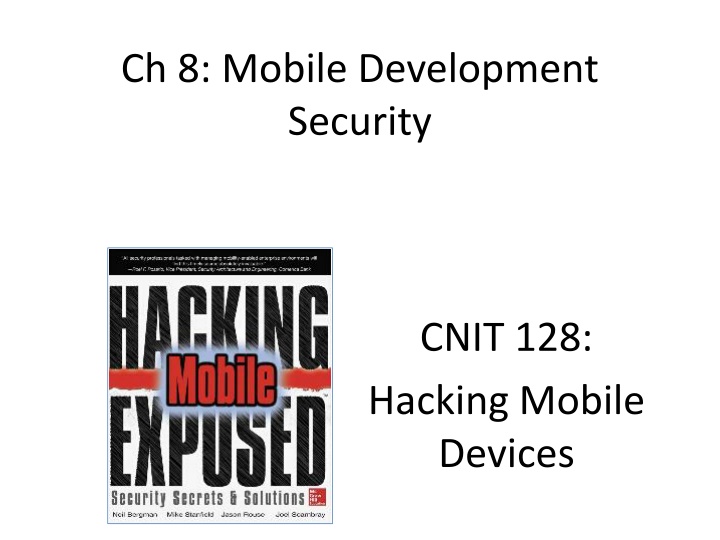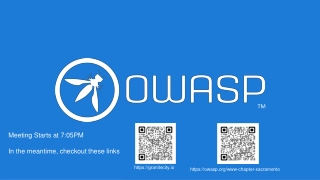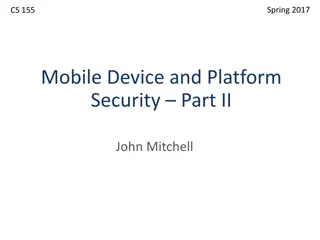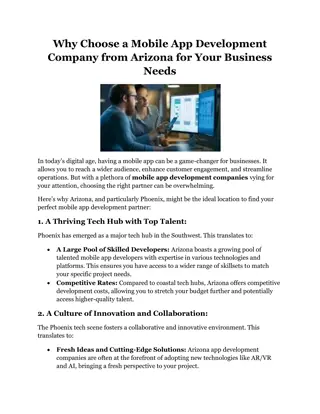Mobile App Security Threat Modeling and Mitigation
Explore mobile app security threats, learn how to conduct threat modeling exercises, and implement mitigation strategies. Discover built-in security features, threat modeling technologies, and common threats like malware and code injection. Enhance your understanding of app security constraints and consider the implications of adding a mobile client to an existing web app.
Download Presentation

Please find below an Image/Link to download the presentation.
The content on the website is provided AS IS for your information and personal use only. It may not be sold, licensed, or shared on other websites without obtaining consent from the author.If you encounter any issues during the download, it is possible that the publisher has removed the file from their server.
You are allowed to download the files provided on this website for personal or commercial use, subject to the condition that they are used lawfully. All files are the property of their respective owners.
The content on the website is provided AS IS for your information and personal use only. It may not be sold, licensed, or shared on other websites without obtaining consent from the author.
E N D
Presentation Transcript
Ch 8: Mobile Development Security CNIT 128: Hacking Mobile Devices
App Security Constraints Built-in security features of the mobile platform Possibility of device theft
Threat Modeling A pencil-and-paper exercise Identifying security risks Helps developer identify most critical risks Focus on features and/or controls to mitigate those risks The alternative is endless, aimless, bug- squashing
Threat Modeling Technologies Microsoft Threat Modeling From 1999 (link Ch 8a) Trike Open-source, began in 2006 (link Ch 8b) More traditional risk management philosophy
Threat Modeling Technologies OCTAVE (Operationally Critical Threat, Asset, and Vulnerability Evaluation) From CERT (link Ch 8c) Cigital Threat Modeling Based on software architecture (link Ch 8d) P.A.S.T.A. (Process for Attack Simulation and Threat Analysis)
Similar Approach Diagram the app Understand where information assets flow Document risks to the assets and security controls Rank the risks by probability and impact Remediate and verify highest-scored risks
Example: Adding a Mobile Client to an Existing Web App New client will support end users and Customer Support Representatives (CSRs) How do existing threats change when a mobile app is added? Enumerate threats Outline assets mobile devices possess Discuss how the mobile tech stacks create opportunities for threats
Threats Web app hacking tools Bluetooth and 801.22 attacks Injecting code into a mobile browser Man-in-The-Browser (MiTB) Malicious apps Malware and Trojans Femtocells Observe all traffic
Threats from Phone's User Download your app and reverse-engineer it Jailbreak the device, subverting controls you depend on Thieves may steal the device and gain access to the UI and physical interfaces such as USB
1. Users as Threats What evil or insidious things could a user do? Steal encryption keys or credentials from apps Reverse-engineer apps What obnoxious or stupid things could a user do to cause trouble?
Other Device "Owners" as Threats Other stakeholders App store account owner App publisher, who provides the user experience and access to mobile services Mobile carrier, e.g. AT&T Device manufacturer: Samsung, etc. App store curator: Apple, Google, Amazon, etc. Company's IT dept. that administers the device
Importance of Other Stakeholders Operate apps and underlying software Control credentials Operate services Carriers and handset manufacturers place apps on the device May customize the OS May place code beneath the OS in firmware
Importance of Other Stakeholders App store curators control a large portion of the app lifecycle Packaging and deployment Update and removal When stakeholder goals differ Opportunity for one "owner" to do something that another stakeholder considers a violation of security or privacy Like collecting and storing personal information
Assets Each stakeholder protects its assets End-users may value privacy App publisher and carrier want to collect and use personal and usage information
Types of Data Offline access Available when phone is not connected to a network Personal data Contacts, voicemails Sensor-based data Location data (GPS and tower telemetry) Camera and microphone data
Identity Data App publishers are reluctant to force users to authenticate using small virtual keyboards Identity data includes Persistent credentials Bearer tokens (such as OAuth) Usernames Device-, user-, or application-specific UUIDs
Usernames If a web-based service uses a mobile device for "out-of-band" password reset And a user has an app for that service Attacker with a stolen phone can reset the password
Threat Modeling Derive the attack surface and potential attacks List assets and stakeholders Brainstorm how each stakeholder might cause a security or privacy breach for another Prioritize attacks by likelihood and impact Implement mitigations Use the list of attacks to drive Secure Software Development Lifecycle
Secure Mobile Development Guidance
Threat modeling Mobile app has two main components Mobile client Mobile Web services that support it Both can be attacked
Native APIs or Mobile Web? Apps written specifically for the platform, using native APIs Take full advantage of the platform's features User interface consistent with platform Mobile Web apps Same as web app, but optimized for a smaller screen Cross-platform mobile development frameworks try to provide the best of both worlds
Device and Runtime Environment Integrity How can an app ensure that the OS hasn't been modified? Or even the app itself? Mobile Device Management Provides some assurance App integrity protection Anti-debugging and code obfuscation
Limitations of Integrity Assurance If device is jailbroken or rooted Environment can lie about what's happening Mobile Application Management (MAM) Some provide private app stores For closed-loop provisioning, patching, uninstallation, monitoring, and remote data wipe Maintaining/Patching your App The app store is the main channel for updates
Secure Mobile App Guidelines Web app security OWASP Top Ten Create a walled garden Requests to Web app should parse the user-agent string Redirect traffic to mobile interfaces/services Don't serve mobile apps same content as computers Legacy content may be aggressively cached by mobile browsers
Secure Mobile App Guidelines Reduce session timeout for mobile devices Greater risk of MiTM attacks Greater risk of device theft Use a secure JavaScript subset Remove eval(), square brackets, "this" Secure JavaScript subsets:
The Dangers of Square Bracket Notation It can even lead to remote code execution Link Ch 8f
Secure Mobile App Guidelines Mask or Tokenize Sensitive Data Mobile devices have aggressive data caching Increased risk of data exposure Replace sensitive data with an alternate representation "mask" or "token"
Secure Mobile App Guidelines Storing sensitive data on the device Avoid storing sensitive data when possible Places to store data, strongest to weakest Security hardware Secure platform storage Mobile databases File system
Mobile Device Sensitive Data Personal data Contacts, pictures, call data, voicemails, etc. Sensor-based data GPS, camera, microphone Identity data Persistent credentials Bearer tokens (like OAuth) Usernames Device-, user-, or application-specific UUIDs
Security Hardware Secure Element (SE) microprocessor Used for mobile payment systems Accessed using existing smartcard standards ISO 7816 (contact) ISO 14443 (contactless) Considered fairly secure Locks out after 5 to 10 failed PIN attempts When used for a virtual wallet BUT general-purpose apps don't have access to the SE
ISO 14443: MIFARE Used by BART and Boston T system MIFARE Classic used a 48-bit key Several vulnerabilities have been found
Secure Platform Storage Apple's keychain SQLite database Protected by an OS service that limits access Keychain items can only be accessed by the app that stored them And other apps from the same developer BUT root user can read the keychain
Keychain Weakness Root user can read everything in the keychain Link Ch 8l
Android KeyStore Intended to store cryptographic keys Has no inherent protection mechanism such as a password Apps must provide a mechanism like this to protect sensitive information; Password from user Use Password-Based Key Derivation Function 2 (PBKDF2) to generate an AES key Encrypt data with AES
Mobile Databases Database can be encrypted with a single secret with third-party extensions to SQLite SEE, SQLCipher, CEROD Apparently innocent data may expose personal identity Such as images SQL injection attacks are possible Via intents or network traffic So use parameterized queries
File System Protections in iOS Default encryption of files on the data partition Centrally erasable metadata Cryptographic linking to a specific device, so files moved from one device to another are unreadable without the key Enabled by default in iOS 5 and above Apple's iOS Security White Paper (link Ch 8m)
File System Protections in Android Files stored in internal storage are private to the app that created them Unless the app changes the default Linux file permissions or uses MODE_WORLD_WRITEABLE or MODE_WORLD_READABLE Files stored in external storage (such as SD cards) are accessible to all applications Android 3.0 and later provides file-system encryption
From March 2, 2015 Link Ch 8o
Authenticating to Mobile Services As previously covered, OAuth and SAML make it possible to avoid storing or using a password in your mobile app As if any developers cared...
Always Generate Your Own Identifiers Apps have used existing identifiers like IMEI number, MAC address, phone number, etc. To identify users and devices But what happens when a device is stolen or sold? Also such identifiers often lack secrecy and entropy Phone number is often publicly listed on Facebook, etc.
More Recommendations Implement a Timeout for Cached Credentials Good for security but inconvenient Rarely done Secure Communications Use Only TLS Direct HTTPS communications resist man-in-the- middle attacks including sslstrip Validate Server Certificates
Use Certificate Pinning for Validating Certificates Adds another step to verifying a server certificate Compares the certificate to a trusted copy of the certificate included in the app Exploits the special relationship between the app and the server The app can be more secure than a Web browser because it knows which server it should be connecting to
WebView Interaction WebView Cache Threats May contain sensitive web form and authentication pages If a user chooses to save credentials in the browser, they are in the cache WebView cookies database could be used to hijack sessions with banks and other websites
WebView Interaction WebView Cache Mitigations Disable autocomplete on all sensitive form inputs Set no-cache HTTP header on server WebView object on the client side can be set to never save authentication data and form data Use clearCache() method to delete files stored locally on the device On Android, you must delete files explicitly because clearCache() doesn't erase them all
WebView Interaction WebView Cache Mitigations To reduce the risk from cached cookies, set up a session timeout on the server Cookies should never be set to persist for a long time To clear cookies on the client, use the CookieManager or the NSHTTPCookieStorage classes On iOS, use NSURLCache to remove cached responses























